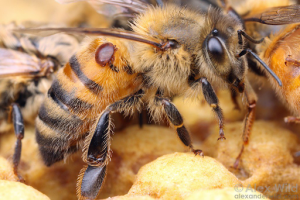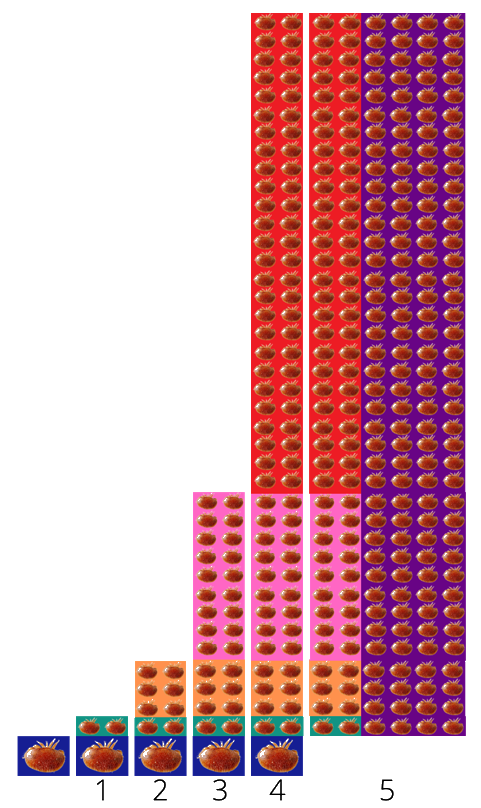Varroa destructor is an ectoparasitic mite that feeds on adult and developing bees. This weakens the bees, reduces body weight, decreases flight performance, causes learning difficulties, and reduces life span. The mite also transmits viruses, which can have a wide variety of effects.
At each point in the Varroa life-cycle (Figure 1) the bees fight back to prevent Varroa populations from exploding.

Figure 1: Top: the Varroa lifecycle. Bottom: the strategies employed by honey bees to prevent mite population growth.
Phoretic phase – on adult bees

Varroa mite on a worker bee inside the hive. (Alexander Wild, The University of Texas at Austin)
The life cycle starts when the Varroa mite emerges from a brood cell. She must find an appropriate adult host. There is a preference for nurse bees. Mites that spend this period on foragers or very young bees are less fertile than those on nurses. At high mite concentrations this preference is lost. Mites on foragers are more likely to be transmitted to another colony.
During this period the bee can fight back by grooming mites off themselves and other bees. Mites can be damaged during grooming, or fall off and get stuck to the bottom of the colony. If the colony swarms then the new colony starts with only the mites that are on the adults. Colonies may also abscond, leaving all the mites in the brood behind.
Next the mite must find a brood cell of the appropriate age to reproduce in. They enter worker brood cells approximately 15 hours before capping, and drone brood cells approximately 45 hours before capping. Mites are attracted by brood pheromones and larval food. Changes in host pheromones may reduce the ability of mites to find appropriate brood cells.
There is a strong preference for drone brood. As drones take longer to develop, more mites are produced on drone brood. Colonies with low drone production will therefore experience slower population growth. Gaps in the brood cycle also slow mite population growth. Swarming introduces a break in the brood cycle of both the bees and the mites.
Reproductive phase – in the brood cell
It takes 3 (on worker brood) to 5 (on drone brood) days for the mite to initiate reproduction. The first egg produced is unfertilized and results in a male. Thereafter the mother lays a fertilised, female, egg every 30 hours. The females mate with their brother when they are about 5-6 days old, unless more than one mite is reproducing in that cell, in which case they can outbreed.
In some populations a large proportion of mites are infertile. Signals (e.g. pheromones, nutrition) from the brood can prevent egg development, and there may be other as-yet unidentified mechanisms.
Workers, detecting a problem with Varroa-infested brood from brood pheromones, may place a hole in the wax cap (uncapping). This changes the temperature and humidity in the brood cell, killing the developing mites. Workers may also remove infested brood from the colony, known as Varroa Sensitive Hygiene (VSH). These actions prevent mite population growth.
Finally, reductions in the length of the post-capping period (the length of time the developing bee takes to pupate) mean that fewer mites have a chance to mature and mate before the bee emerges. In warmer parts of the world the bee brood cycle is shorter, and this may contribute to Varroa resistance in these populations.
Fighting back
So now you know how honey bees fight back against Varroa. How can we fight back?
How can we fight back?
The best strategy is eradication. It is important that everyone follows biosecurity guidelines to give us the best chance of achieving eradication. Eradication is achievable. Australia successfully eradicated Varroa jacobsoni from Townsville.
If eradication becomes unachievable then treatment and breeding will become important. The Plan Bee Breeding Manual will be updated in the coming months to include Varroa resistance traits.
Population growth
In worker brood a foundress can produce 1-2 mature females per cycle. In drone brood they produce 2-3.
Lifespan varies depending on the time of year, from 25 days to 5 months. Typically, they can complete 3-4 cycles (Figure 2).

Figure 2: This figure models the Varroa population arising from a single foundress (blue). It is based on worst-case-scenario for production in worker brood: the foundress produces 2 mature females per brood cycle and completes 4 brood cycles (1-4) before dying (5). Her offspring also produce 2 mature females per brood cycle. In the 5th brood cycle she dies and leaves 234 descendants. The males don’t emerge with adult bee, so they are not considered.
Acknowledgements:
- Huang (2012) Varroa mite reproductive biology
- Plant Health Australia Varroa mites
- Plan Bee (National Honey Bee Genetic Improvement Program) is supported by funding from the Australian Government Department of Agriculture, Water and the Environment as part of its Rural Research and Development for Profit program. The project is further supported by AgriFutures Australia, the Department of Regional NSW, University of Sydney, University of New England Animal Genetics and Breeding Unit, Better Bees WA Inc, Wheen Bee Foundation, Costa Group, Olam, Beechworth Honey, Monson’s Honey and Pollination, South Pacific Seeds, Australian Queen Bee Breeders Association, Australian Honey Bee Industry Council, and commercial beekeepers.
- This article was peer-reviewed by Erica Mo and Elizabeth Frost.

